Category Archives: Fish Profile

Metallic Foxface
The below Fox Face profile is based on what I have learned and observed. They certainly are great looking and active fish, adding a lot of viewing pleasure to any community aquarium. Please keep in mind there are many different types of Foxface fish that will have different coloring and patterns of coloring. I will only be referring to one type of Foxface.
Common Name: Metallic Foxface, Metallic Foxface rabbitfish, Magnificent Foxface, Andaman Foxface, or the Red Fin Foxface
Scientific Name: Siganus magnificus
Reef Safe: Yes, when well fed and cared for
Temperament: Very Peaceful
Care Level: Easy
Max Size: 8 to 9 inches (around 8 is more common)
Appearance:
They have the common white face with the black band as all different types of Foxface will have. Its body is mostly white in color and will have a large patch of black to dark silver coloring closer the dorsal fin. All of the fins will have a red to yellow colored boarder around the outside edges. Other types of Foxface will have different coloring.
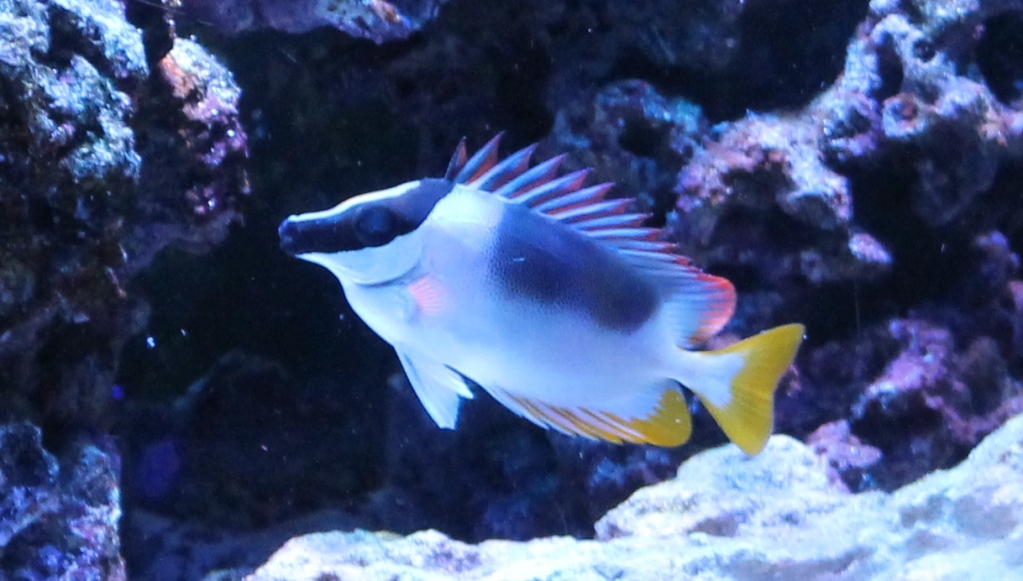


Temperament
They are a very peaceful fish that seldom reacts to fish that are very similar in appearance, size, and color. It would not recommended to keep more than one Foxface in your aquarium as I do not believe you could accurately predict the potential reaction to having two Foxface in the same aquarium.
Environment
This fish will need at least a 75 gallon tank, but would do better in a 125 gallon tank. Lots of live rock will benefit this fish as the Foxface also likes to pick at some of the algaes that can grow in your aquarium. They can spook easily so you should have a few hiding spots within the live rock for the Foxface to go to. The Foxface is also reef safe when well fed.
Recommended water conditions:
Although the Foxface is a hardy fish, I would still refer you to the below article for the typical water conditions that a Metallic Foxface will do best in:
https://www.reefaquarium.com/2013/the-basics-of-marine-aquarium-water-parameters/
Diet
The Foxface is an omnivore. It will benefit from a wide range of meaty foods (like mysis and brine shrimp for example) as well as a good amount of marine algaes. A combination of carnivore and herbivore based marine flake or pellet food would also be good options for a Foxface.
Note:
You should be aware the spines on the dorsal fin of the Foxface are very sharp and venomous. Be careful when handling a Foxface to avoid contact with the dorsal fin. You should also be careful when you have your hands in the aquarium not to spook or corner the Foxface to prevent it from accidently stinging you. If you do get stung, soak the area of the sting in hot water (as hot as you can stand). If you see any type of allergic reaction such as hives, a rash or redness coloring, and swelling moving out from the area of the sting, seek medical attention immediately. Just by being careful, you should easily be able to avoid ever being stung by the dorsal fin.

Sailfin Tang
Common Name: Sailfin Tang, Desjardini Sailfin Tang, Indian Ocean Sailfin Tang, Red Sea Sailfin Tang.
Scientific Name: Zebrasoma Desjardini
Reef Safe: With Caution
Temperament: Semi-Aggressive
Care Level: Moderate
Max Size: 14 to 15 inches (around 10 to 11 is more common)
Appearance:
This Sailfin tang will have a silver or grey colored body with vertical yellow stripes and varying sized dots (or freckles) on the body, face, and tail. They tail will have a blue like tint to it under the correct lighting conditions. The Sailfin tang gets its name from the dorsal and anal fins which, when extended, will make this fish appear to be twice as large as it is.
Juvenile Sailfin tangs will not have any of the above described spots on them as that will slowly develop as the fish starts to mature.
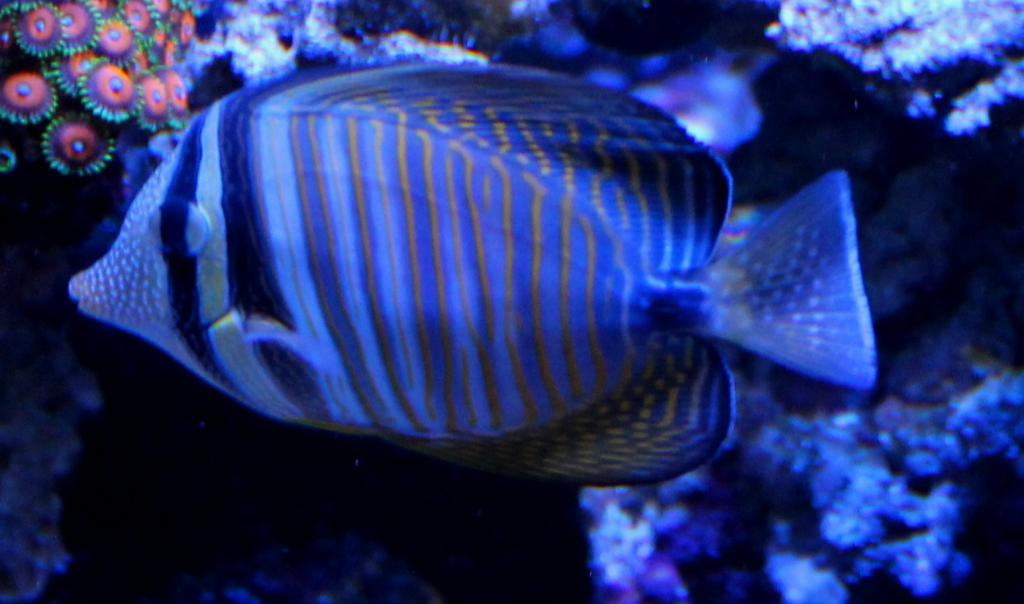

Temperament
Although they are generally reef safe, they sometimes can pick at clam mantels or LPS corals with soft tissues. They should not be kept with other Sailfin tangs or other tangs that will look similar to the Sailfin such as yellow tangs for example. The Sailfin tang should be added last to the aquarium in order to reduce the chance of any aggression.
Environment
These tangs will do best in a 180 gallon aquarium with a lot of live rock to pick at as well as hiding spots to go to should the tang feel threatened.
Recommended water conditions:
I would refer you to the below article for the typical water conditions that a Sailfin tang will do best in. You have to keep in mind, as a moderately difficult fish, they will need very good and very stable water conditions.
https://www.reefaquarium.com/2013/the-basics-of-marine-aquarium-water-parameters/
Diet
As with most tangs, the sailfin tang will accept almost any food you may offer it. However, they are herbivores and will require a diet consisting mostly of sea algaes with some other verities of food on occasion. A good quality flake or pellet food meant for marine herbivores is also a good option for the Sailfin tang’s main diet.
A reference for your consideration
https://www.reefaquarium.com/2013/responsible-fish-keeping/
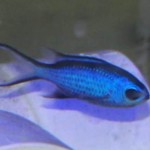
Reef Chromis
Common Name: Blue Reef Chromis, Blue Chromis
Scientific Name: Chromis Cyaneus
Reef Safe: Yes
Temperament: Peaceful
Care Level: Easy
Max Size: 5 inches
Appearance:
This chromis is darker blue in color with black edging around the fines and a black coloring on the head around the eyes.

Temperament
The Reef Chromis are a schooling fish and should be kept in numbers of between 6 and 10. As chromis are closely related to the damselfish species, there can be slightly aggressive behavior observed between the reef chromis in an aquarium when they are establishing a “pecking order” among the school. This aggression can get bad at times but it typically will be short lived.
Environment
I would suggest nothing less than a 55 or 75 gallon tank as you would need to keep them in a school and they are very active fish. Many hobbyists will use reef chromis as a dither fish to provide a lot of swimming activity in the aquarium making other shy fish feel more comfortable and safe in the aquarium.
Recommended water conditions:
Although these are very hardy fish, I would still refer you to the below article for the typical water conditions that reef chromis will do best in:
https://www.reefaquarium.com/2013/the-basics-of-marine-aquarium-water-parameters/
Diet
Reef Chromis are omnivores and will do best when offered a variety of meaty foods along with a mixture of different types of marine flakes and pellets.

Starry Blenny
The below Starry Blenny profile is based on what I have learned and observed. They certainly can have just about the most personality of any marine fish making them a great addition to almost any community aquarium.
Common Name: Starry Blenny, Snowflake Blenny, Starry Lawnmower Blenny (not to be confused with a Lawnmover Blenny)
Scientific Name: Salarias Ramosus
Reef Safe: Yes
Temperament: Peaceful
Care Level: Easy
Max Size: 5 to 6 inches
Appearance:
They have a dark brown to brown color with a lot of white spots along their body. The pectoral and tail fins will also be a lighter color and sometimes even have a bit of a yellowish tint to them. They also have a very interesting looking small whisker like appendage on their head next to their eyes.

Temperament
They are very peaceful fish. However, you need to use caution when keeping them with other fish that have a similar shape and color. They have also been known to become very territorial with other blennies unless you are lucky enough to get a mated pair. I would not recommend having more than one in a tank smaller than 125 to 180 gallons and recommend caution with doing so.
Environment
The Starry Blenny can be kept in a 30 gallon aquarium as they do not require a lot of swimming space. They will need a lot of live rock as they prefer to hop around on the rocks, often stopping to sit a while and watch what is going on around them. Make sure your rock is safely stacked as this Blenny has been known to dig around a little around the rocks. There should also be a few hiding spots for this Blenny to go to should he feel threatened. They are reef safe. You should also have a lid on your aquarium as there is a small chance a Starry Blenny can become a jumper in a open top tank.
Recommended water conditions:
I would refer you to the below article for the typical water conditions that a Starry Blenny will do best in:
https://www.reefaquarium.com/2013/the-basics-of-marine-aquarium-water-parameters/
Diet
The Starry Blenny is an herbivore. Although they may enjoy meaty foods, they will need a diet that consists of mostly marine algaes and can also benefit from an herbivore based marine flake or pellet food. The Starry Blenny will make a good addition to your clean-up crew as they will eat many different types of marine algaes that will develop in an aquarium. For this reason, you should only add a Starry Blenny to a well matured aquarium that will provide some algae for him to snack on in between feedings.
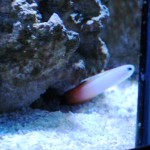
Firefish
Common Name: Firefish, Fire Dartfish, Magnifica Dartfish, Fire Goby, Firefish Goby.
Scientific Name: Nemateleotris magnifica
Reef Safe: Yes
Temperament: Peaceful
Care Level: Easy
Max Size: 3 to 4 inches
Appearance:
These are very attractive looking little fish. The head will have slight yellow like coloring to it followed by white coloring back to about the midpoint of the body. From the midpoint of the body to the end of the tail fin, the Firefish will have a striking red color. The fins will also have a black trim or boarder to them.
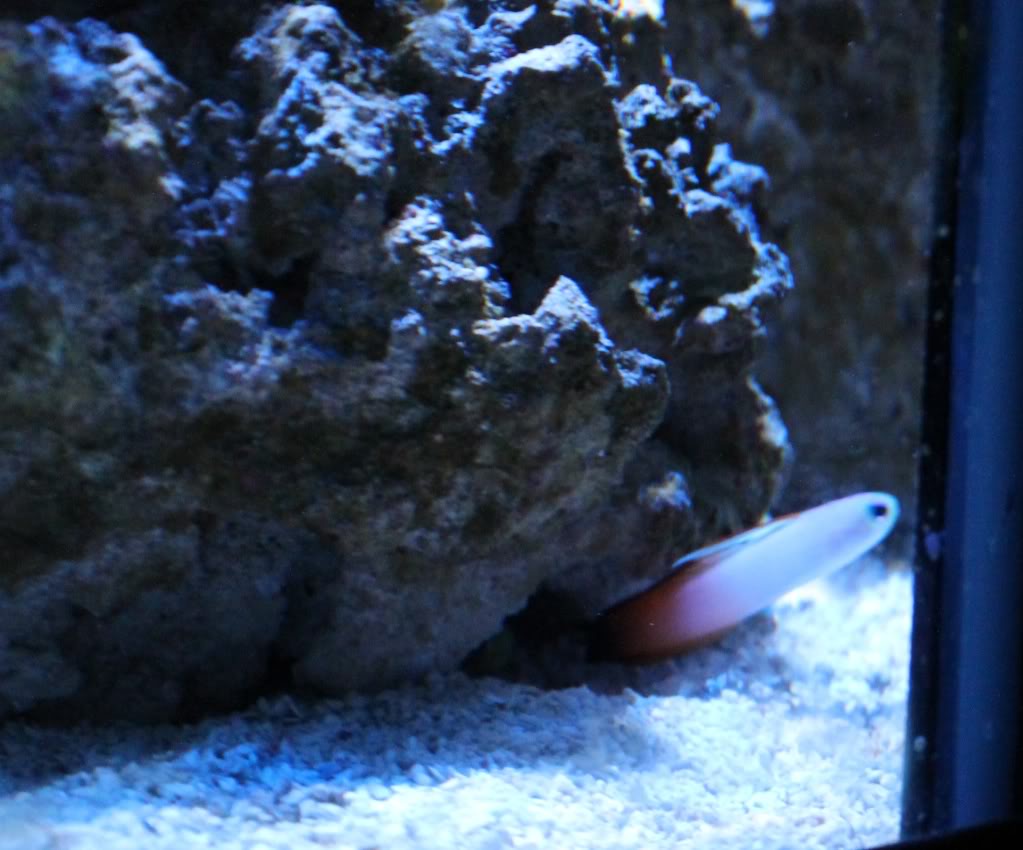
Temperament
These are fairly peaceful fish. The only time you may experience any aggression would be when kept with other members of its own species unless you get a mated pair.
Environment
As this is a very small fish, you can keep one in a tank as small as 20 gallons. They will need smaller hiding spots throughout the aquarium within the live rock for this fish to go to when it feels stressed or threatened. The Firefish has also been known to be a jumper so it would be best to have glass tops or a canopy on your aquarium. They will do best when added to a mature set-up.
Recommended water conditions:
I would refer you to the below article for the typical water conditions that a Firefish will do best in:
https://www.reefaquarium.com/2013/the-basics-of-marine-aquarium-water-parameters/
Diet
As these fish are omnivores, they will do best when offered a combination of frozen foods such as brine shrimp along with algae based marine flake or pellet foods. They will also eat algae and different types of plankton, pods, and larvae that can naturally develop in your aquarium.

Orange Tail Butterflyfish
Common Name: Mertensii Butterflyfish, Orange Tail Butterflyfish, Crowned Pearlyscale Butterflyfish
Scientific Name: Chaetodon Mertensii
Reef Safe: No
Temperament: Peaceful to Semi-Aggressive
Care Level: Moderate
Max Size: 10 inches (around 8 is more common)
Appearance:
Its body is silver to grey color with black lines (or markings) that form a patter on its body. It will also have a black strip with a silver trim across both eyes. The back ¼ to 1/8 of its body will be a solid orange color without any markings.

Temperament
They are a peaceful for the most part but can become territorial. When kept with other types of Butterflyfish, they are highly likely to become territorial resulting in some aggression. I would not recommend keeping more than one in an aquarium.
Environment
They are a fairly active fish that will need at least a 75 gallon aquarium. They are very likely to eat most types of LPS, soft corals, and even nip at clam mantels and even anemones in some cases. They will do best in FOWLR set-ups with more peaceful fish that do not look like a Butterflyfish.
Recommended water conditions:
I would refer you to the below article for the typical water conditions which this Butterflyfish will do best in. As with most fish that are moderately hard to keep, you will need to maintain very good and very stable water parameters for this fish
https://www.reefaquarium.com/2013/the-basics-of-marine-aquarium-water-parameters/
Diet
As they are carnivores in the wild, they will do best when offered meaty frozen foods along with a good quality marine flake or pellet food which is intended for carnivores. They will also benefit from a frozen food which also contains sponges.

Orange Back Wrasse
Common Name: Orange Back Wrasse, Orange-Back Fairy Wrasse,
Scientific Name: Cirrhilabrus Aurantidorsalis
Reef Safe: Yes
Temperament: Peaceful
Care Level: Easy
Max Size: 3.5 to 4.5 inches
Appearance:
This is a very colorful fish. The body of the fish is a vibrant blue like color, and (as the name suggests), they have a brightly colored orange back running the full length of the body, from the head to the tail. Males will have an additional dark red or burgundy coloring on the head. There can be some slight color variations among different orange back wrasses. The male’s coloring can darken up a little as a part of the mating process.


Temperament
These are very peaceful and active fish. I would not suggest keeping more than one in an aquarium unless you have a male and female pair.
Environment
The Orange Back Wrasse will need at least a 55 gallon aquarium as this is a very active fish that doesn’t like to stay still for very long at all. They will need some hiding spots among the live rock in your aquarium to go to when they feel threatened. They have also been known to jump out of aquariums so it is advisable to have a canopy or glass tops on your aquarium.
Recommended water conditions:
I would refer you to the below article for the typical water conditions which this wrasse will do best in:
https://www.reefaquarium.com/2013/the-basics-of-marine-aquarium-water-parameters/
Diet
As with most wrasses, they are carnivores. They will do best when offered a variety of different meaty food along with marine flake or pellet foods meant for carnivores.
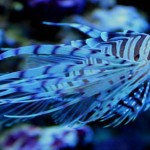
Russels Lionfish
The below Lionfish profile is based on what I have learned and observed about the Russels Lionfish. They certainly are beautiful fish to keep and will add a lot of interesting viewing pleasure to any aquarium.
Common Name: Russel’s Lionfish, Red Volitan Lionfish, Soldier Lionfish,
Scientific Name: Pterois russelii
Reef Safe: Yes
Temperament: Predator, but peaceful in the right set-up
Care Level: Moderate
Max Size: 8 to 10 inches (refers to the body size excluding the fins)
Appearance:
This is one of smaller of the larger bodied lionfish. They have all the typical fins as with any of the larger lionfish. The coloring of their stripes will be red to brown in color. It can be easy to mistake a Russels Lionfish with other larger bodied lionfish if you do not know what to look for. There are three key differences to look for. 1) The tailfin will not have any spots on it as other large bodied lionfish will have. 2) The Russels bottom jaw and chin will also be white which is another difference from the other larger bodied lionfish. And finally 3) The spins along the dorsal, pectoral and anal fins are not banded and more fleshly than other lionfish.
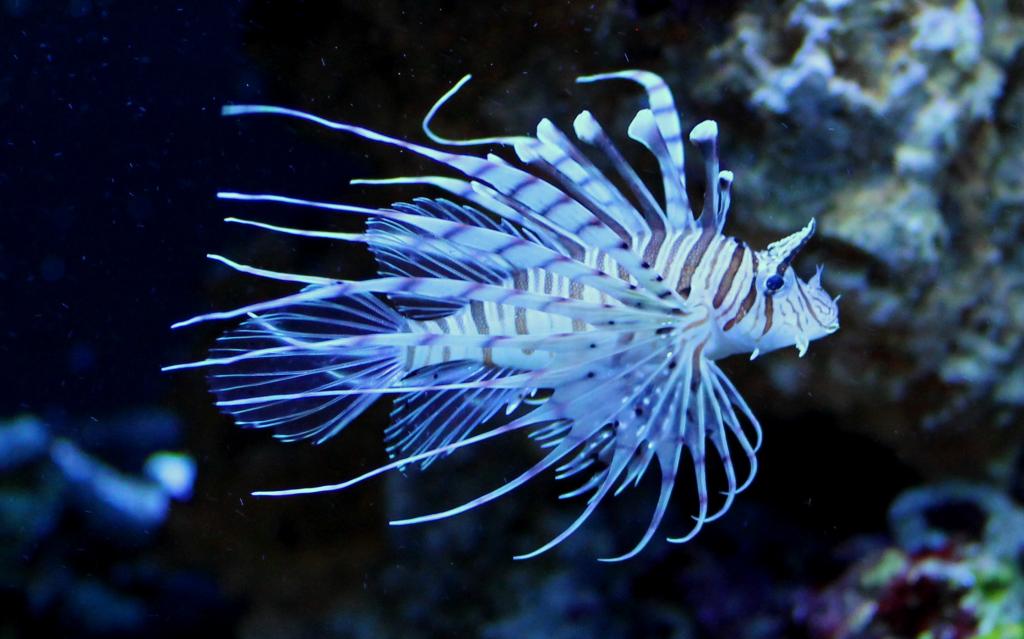
Temperament
They will do perfectly fine with other fish of similar size and can be a very peaceful community fish when kept with the correct tankmates. However, when kept with fish that have a body of about ½ of the lionfish’s body size; it will only be a matter of time before the lionfish will try to eat it. They are among the better predators common in the hobby. Although you can keep multiple Lionfish in the same aquarium, you should use caution when doing so. You would need to ensure they are bith a very similar size and added at the same time to increase your chances of success. One of the Lionfish can become very dominant and will bully the others steeling all the food when you feed the tank
Environment
I would suggest a 90 gallon aquarium would be the minimum size for a single Russels. The need swimming space both around rocks and out in the open. The do best when provided shelf like structured that they can hang up-side from as well as cave structures they can sit in. The below is an example of both. Lionfish can be kept with corals.
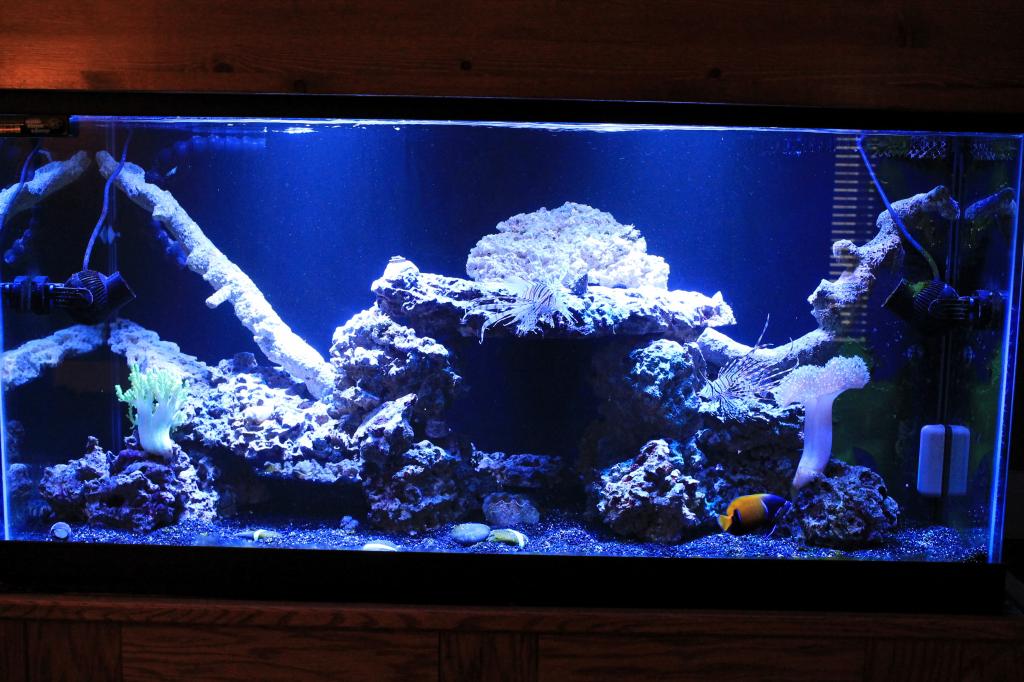
Recommended water conditions:
I would refer you to the below article for the typical water conditions that a Russel’s Lionfish will do best in:
https://www.reefaquarium.com/2013/the-basics-of-marine-aquarium-water-parameters/
Diet
Getting this Lionfish to eat a healthy diet for it’s long term health is one of the biggest reasons for hobbyist having difficulties keeping lionfish. As the lionfish is a predator, they are used to eating live fish that are anywhere about ½ their body size or less. It can be difficult to get them to switch to eating meaty frozen foods and/or pellets for marine carnivores
I have had great success by using a very long pair of tweezers to take a smaller and longer peace of frozen food and wiggling it in the aquarium near the lionfish. This makes it look alive and the lionfish will typically eat it after a few days to a week of trying. Other hobbyist has also had great success with this approach by sticking the food on a small wood stick (like you use to make shish kabob). Once they are eating the wiggling food and have gotten used to it, I will start to wiggle the food less and less slowly getting them used to eating food that doesn’t look alive. Once they are at this point, you can just add the food to the tank and they will “hunt” it down and eat it. This is why I always suggest buying a lionfish that is already eating frozen foods so the above process will be a lot easier for you.
The above process is a proven one that works. Many people get frustrated and give up trying only to offer the lionfish live foods like feeder goldfish. I do not recommend feeding your lionfish feeder goldfish for two reasons; 1) freshwater fish to not have the same mineral and fatty tissues that marine fish have which will not provide the lionfish with the proper nutrients it will need for long-term health, and 2) The lionfish will always favor live food over frozen as that is instinctive to them. This will set-back your efforts to get the lionfish to eat frozen foods. I would not even offer a lionfish live foods as the occasional treat.
Once you get your lionfish eating frozen foods, they will need a variety of different meaty foods like: prawns, large Mysis shrimp. The below thread will give you some better ideas for feeding a lionfish a diet that will help them have along and healthy life in your tank.
https://www.reefaquarium.com/2012/feeding-high-quality-froozen-foods/
Be careful not to overfeed a lionfish as they have been known to overeat to the point of creating an internal blockage if given the chance. Just feed enough until you see a slight bulge in their stomach. Feed every second day as juveniles and about three times a week as adults.
Special considerations
1) Feeding by hand
I never recommend feeding your lionfish by hand. Although they will readily take the food form you, over time they will learn to associate your hand with feeding. When you try to put your hands in the tank for reasons other than feeding, the lionfish will still think they are about to get fed and swim up very close to your hand. That can put you at some risk of getting bit or stung depending on the exact personality of your lionfish
2) Venomous Spins
The long dorsal fin of the lionfish contains venomous spins. If you get stung by one, it is going the hurt a lot like a very bad bee sting, or at least that is what I have heard. If you get stung by one, soak the stung part in hot water (as hot as you can stand it) for about 15 or 20 minutes. If you see any signs of a allergic reaction, seek medical attention immediately. I have found the best way not to get stung (accidently or otherwise) is to make sure you do not spook or corner the lionfish when you put your hands in the tank.
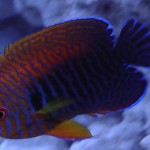
Potter’s Angelfish
Common Name: Potter’s Angelfish, Potter’s Dwarf Angelfish
Scientific Name: Centropyge Potteri
Reef Safe: With Caution
Temperament: Semi-aggressive
Care Level: Moderate
Max Size: 4 to 5 inches
Appearance:
The potter’s angelfish is a very nice looking dwarf angelfish which is what attracts many hobbyists to keeping them. Its body is a very vibrant orange color that has dark blue coloring running along the body as well with a grey to silver colored line pattern overtop. The fins are typically a dark blue color with a slightly lighter blue edge.

Temperament
This fish may sometimes be aggressive to smaller fish or fish with similar appearance and coloring. I would not recommend keeping a potter’s angelfish with another potter’s angelfish or any other dwarf angelfish as that will result in territorial behaviors and aggression. These fish do best when they are the only dwarf angelfish in the aquarium. Adding the potter’s angelfish last to your set-up will also help to reduce the risks of aggression.
Environment
The potter’s angelfish is a very active fish that would need at least a 55 gallon tank with live rock that provides multiple hiding spots for the potter’s angelfish to go to when it feels threatened. A 75 gallon aquarium would be a lot better for this fish. They will also need to be placed in a mature set-up as they need lots of live rock to pick at. Use caution and carful observation when adding this fish to a reef set-up. Some of them have been known to nip at soft corals (like zoas) and some LPS corals with soft outer tissues (like brain and donut corals). This risk can also be reduced when the potter’s angel is added to a mature set-up with different types of algaes for the fish to pick at and eat.
Recommended water conditions:
I would refer you to the below article for the typical water conditions that a potter’s angelfish will do best in. As with most fish that are moderately hard to keep, you must provide good and stable water conditions for their long-term health.
https://www.reefaquarium.com/2013/the-basics-of-marine-aquarium-water-parameters/
Diet
The potter’s angelfish is an omnivore. They will do best when offer a variety of meaty foods as well as marine algaes. Marine flakes or pellets made from marine algaes are also good foods to offer. Feeding the potter’s angelfish prepared foods for marine angelfish will also benefit them. They will also spend most of their days picking at the live rock in the tank eating different types of algaes as well as pods and other little critters that develop in a mature set-up.

Six Line Wrasse
Common Name: Six Line Wrasse, Sixstripe Wrasse
Scientific Name: Pseudocheilinus Hexataenia
Reef Safe: Yes
Temperament: Peaceful
Care Level: Easy
Max Size: 2 to 3 inches
Appearance:
This is another colorful wrasse. They have a purple coloring to their bodies with six orange colored horizontal lines running the full length of their body. They will also have stripes of a white to yellow or gold coloring running across both eyes. The dorsal fin will typically have some orange coloring on it and the tail find will have some green coloring on it.

Temperament
This is a very peaceful fish when kept with other peaceful fish. The sixline should be the last fish added to the aquarium to greatly reduce any chances of aggression. They should be the only six line wrasse in the aquarium as they will get very aggressive toward other six line wrasses in most situations.
Environment
As this is a very small fish, it can be kept in an aquarium as small as 20 gallons provided there is a lot of live rock while still leaving a far amount of swimming space within the tank. They do best with live rock as they like to scavenge for food in the rocks as well as hid in the rocks when they feel threatened. They have also been known to eat a lot of aquarium pests such as certain types of flat worms. You should also have a few inches of substrate on the bottom of the tank as this fish will sometimes burry itself into the substrate in order to hide when it feels stressed.
Recommended water conditions:
I would refer you to the below article for the typical water conditions this wrasse will do best in:
https://www.reefaquarium.com/2013/the-basics-of-marine-aquarium-water-parameters/
Diet:
As with most wrasses, they are carnivores. They will do best when offered a variety of different meaty foods along with marine flake or pellet foods meant for carnivores.